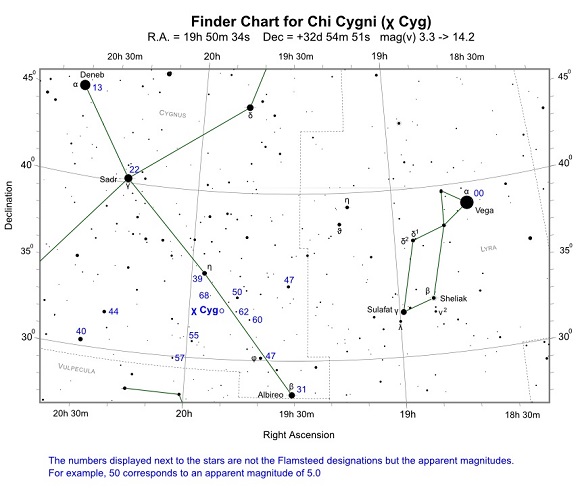Chi Cygni is a long period variable star that returns to peak brightness during early to middle August 2015. Already the star has reached naked eye brightness; at the beginning of the month it hit magnitude +5.0 and with a more days to go before maximum it's expected to brighten to at least magnitude +4.0.
What makes Chi Cyg fascinating is that it's a Mira type variable with an extremely large brightness range. Mira type stars are pulsating red giants that vary by at least one magnitude over periods ranging from 80 to over 1,000 day's. These stars are coming to the end of their lives and will eventually form a planetary nebula with a white dwarf at the centre. There are at least 6,000 known Mira type stars.
Chi Cyg is the second brightest Mira star (after Mira - omicron Ceti) and has been known to brighten up to magnitude +3.3 and fade down to magnitude +14.2 over a period of 407 days. However every cycle is different. Often the star is visible to the naked eye at brightest but not always. For example, the 2014 maximum was one of the faintest on record at magnitude +6.5. At the opposite end of the scale Chi Cyg can dip down to about as faint as dwarf planet Pluto, hence requiring at least a 250mm (10-inch) scope to be spotted!

The star is located in the Milky Way rich northern constellation of Cygnus. It's positioned just over half way along an imaginary line connecting phi Cyg (φ Cyg - mag. +4.7) to eta Cyg (η Cyg - mag. +3.9). From northern temperate latitudes, Cygnus is almost overhead during the summer months.
It's fascinating to follow a star through such an extreme brightness range, from naked-eye visibility to the edge of binocular visibility in only a matter of a few months. So don't miss Chi Cygni this year!
You can submit your magnitude estimates to both the British Astronomical Association's Variable Star Section or the American Association of Variable Stars.

Chi Cygni Finder and Comparison Star Chart - pdf format
Chi Cygni Data Table
| Name | Chi Cyg |
|---|---|
| Bayer | χ Cyg |
| Constellation | Cygnus |
| RA (J2000) | 19h 50m 34s |
| DEC (J2000) | +32d 54m 51s |
| Distance (ly) | 550 |
| Apparent Mag. Range | 3.3 -> 14.2 |
| Absolute Mag. Range | -3 -> 8 |
| Period (days) | 407 |
| Type | Mira type variable star |
| Spectral Type | S6 III |
| Radius (Sol) | 320 |
| Surface Temp. (K) | 3000 |
| Other designations | HD 187796, HIP 97629, HR 7564 |
| Notable features | Brightest Mira star in the northern section of the sky |